LSD (lysergic acid diethylamide) is a powerful hallucinogenic. It was first synthesized in 1938 by Swiss chemist Albert Hoffman. Hoffman based the drug off compounds found in the ergot fungus, which grows on rye and related plants and grains. Ergot can produce horrifying symptoms, including psychosis and gangrene.
After taking LSD, a person usually feels the effects after 30 to 90 minutes. The effects on the brain are somewhat unpredictable, depending on the dose taken. If a large dose is taken, the drug could produce hallucinations and delusions. The drug can also cause a person to perceive time as slowing down, have impaired depth perception, and have distorted perceptions of objects.
The drug affects numerous nerve receptors, including dopamine, adrenergic, and serotonin. Serotonin appears in many places in the body, including the gastrointestinal tract and in blood platelets. However, as a neurotransmitter, serotonin is involved in your mood, appetite, sleep, memory and learning, sexual desire, and feelings. The specific serotonin receptor involved in making you hallucinate is 5-HT2A. These receptors play a large role in the visual cortex. Scientists are unsure how LSD affects receptors, but they know 5-HT2A is affected.








